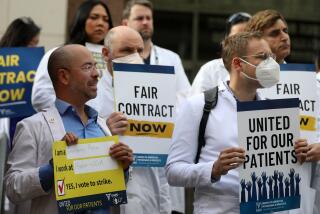Dependence on Employer Leaves Many Uncovered : Benefits: Of the uninsured in L.A. County, four out of five are workers or their dependents. ‘Small business is getting a free ride,’ one critic says.
- Share via
From the Long Beach office of his nursery company, so stricken by the regional economic downturn that it has downsized by half in the past five years, Tom Lucas contemplates his small role in Los Angeles County’s health care crisis.
“I would love to be able to afford health insurance for my employees,” he says. “I think they deserve a lot--they work their butts off. There would be less stress in their lives, which would mean less stress in our lives.”
But the long slump in the regional real estate market has taken the bounce out of his business. Lucas shut down a landscaping service in 1991 that only five years earlier had employed 40 workers. Nurseries liquidating their stock around the Southland keep plant prices, and margins, low. Customers’ unpaid bills have soared.
“It wouldn’t take much more for me to decide this isn’t much fun anymore and liquidate,” he says. “Health insurance would put me out of business.”
Consequently, many of his 23 employees may have little choice when they or their dependents get sick but to go to a county clinic or medical center. And that makes them part of a telling statistic: Of the more than 2.6 million residents of Los Angeles County who are medically uninsured, four out of five are workers or their dependents. According to a study by the UCLA Center for Health Policy Research, more than half of those workers are employed full time.
These are the people for whom county-financed facilities are the health centers of first and last resort. Most are too well-off to qualify for Medi-Cal or Medicaid, state and federal programs that would reimburse the county for their treatment.
But even in cases where their employers offer them access to insurance--perhaps picking up a fraction of the premiums--they are too poor to afford the $100 or more they would have to pay every month to cover themselves and their families.
“Nobody pays much attention to the fact that you have people who have been working full time for 15 years who don’t have health insurance,” says Jennifer Skurnik, an organizer for Los Angeles-based Local 11 of the Hotel and Restaurant Employees Union, which makes fully paid health insurance a cornerstone of its contracts.
Whether there is something wrong with employers taking a subsidy, in effect, from county taxpayers by not providing health insurance is a matter of debate.
“I’ll tell you who gets the free ride in this, when you look at the UCLA data on the uninsured in the county,” says Jonathan Friedman, chief of staff to Burt Margolin, the county health czar. “When two-thirds of the uninsured work or are dependents of full-time employees, small business is getting a free ride.”
“It’s absolutely going on” that private employers are ceding their responsibility to provide health coverage for employees to the county, says E. Richard Brown, head of the UCLA center. “Health insurance is too expensive for even middle-income workers to afford on their own.” Meanwhile, “employers are dropping the coverage or making it more expensive.”
Others note that the United States is unique in the industrialized world in its reliance on employers, rather than government, to provide health coverage.
“I’m not sure it’s fair to say it’s the employer’s responsibility,” says James Lott, senior vice president for policy development at the Health Care Assn. of Southern California, a trade group for private hospitals and other medical centers. Employer-paid health insurance in this country, he notes, is a relic of the post-World War II era, when trade unions got around government wage controls by negotiating health benefits instead of higher pay. Since then, federal initiatives to take over the medical insurance system have failed--most recently last year.
For Los Angeles, the result is that the scarcity and cost of employer-provided health insurance in lower-paying service industries is perhaps the leading reason the public health system is in dire straits.
The percentage of Los Angeles County residents without private or public insurance has remained higher than the state and national averages for years, according to researchers at the UCLA center, which has tracked the phenomenon. County residents who neither receive insurance through their employers nor qualify for federal or state coverage through Medicare or Medi-Cal make up the largest group of users of county clinics and medical centers.
There is little disagreement over why Los Angeles County’s workers are so poorly covered: A disproportionate share of its employers are in low-paying manufacturing and service industries exploiting immigrant labor and surviving on rock-bottom profit margins.
UCLA figures show that in the garment and food processing industries 42% of all workers ages 18 to 64 are uninsured--the highest ratio of all industry groups except farming and fishing, where reliance on migrant labor drives the figure up to 70%.
“The entire atmosphere [in the garment sector] is hostile to health insurance,” says Steve Nutter, regional director of the Union of Needle Trades, Industrial and Textile Employees.
Garment executives say the industry’s dynamics keep pay low and benefits scanty. Typically, apparel manufacturers in the Southland farm out the cutting and sewing of their garments to thousands of registered contracting shops that compete for the business with each other and with thousands more unregistered shops paying illegally low wages to illegal workers.
“Thirty percent to 60% of all apparel manufacturing in Southern California is done by unregistered, untaxed, cash-paying shops,” says Robert Walter, vice president of Frank Walter Sportswear, a sewing contractor serving manufacturers of girls clothing. “If all the sewing contractors and apparel manufacturers were registered and paid taxes, we wouldn’t be having this health care problem.”
Not only do the unregistered shops deprive the county of tax revenue and strain its public services, Walter argues, they also drive down prevailing market rates.
Walter restored health insurance as a benefit to his workers Jan. 1 after eliminating it for about 15 months; before that health insurance had been a staple of his company’s benefits package since 1962.
“Manufacturers and retailers weren’t willing to pay legitimate contractors with legitimate employees to do a good job,” he says of that period. “With our tight margins, there was no way we could offer health insurance--we even went $50,000 in debt before we decided to drop it.”
Walter was able to restore the coverage only after prices paid for his wares rose and he took steps to reduce his company overhead, including reducing the work force to about 80 from 90.
Even so, he says, contractors who don’t offer health benefits are able to undercut his prices by as much as 20%.
“We lose business,” he says. “Very honestly, our cost to a manufacturer for a garment is going to be higher than someone else’s. Whether we have a clean factory or offer health insurance to our workers, the manufacturer doesn’t care. It’s a shame.”
Industry officials say Walter’s work force remains an exception to the rule that workers in Los Angeles’ garment trades get their health care from county facilities or even from doctors at home in Mexico or elsewhere in Central America. (Mexican and Central American immigrants make up more than 75% of the overall industry work force and as much as 50% of those employed in registered shops, says Joseph Rodriguez, executive director of the Los Angeles Assn. of Garment Contractors. Of the group’s 150 members, fewer than five provide health insurance to workers, he says.)
In fact, even workers who have access to health insurance often resort to county facilities or travel home for certain procedures. Lupe Trigueros, a mini-bar attendant at the New Otani hotel in Downtown Los Angeles who pays $110 a month to cover herself and four children through a program offered by the hotel, says she would consider taking her children to county clinics for treatment if they were closer to where she lives.
Trigueros, who is involved in Local 11’s effort to unionize the hotel, notes that the cost of health insurance has gone up virtually every year since the New Otani ended its program of covering the entire premium itself. (Hotel officials did not respond to a request for comment.)
For now, business leaders and health industry professionals see few options to bring health insurance to more low-paid workers. Industry groups have strenuously opposed state laws that would require fuller coverage, arguing that raising expenses for small firms will simply drive many out of business and cede trade to out-of-state competitors. Similar federal initiatives perished with the Clinton Administration’s health care reform last year.
The state has sponsored programs to reduce the cost of health insurance for small businesses, but the success at enticing employers to join up is still modest.
The most prominent of these, the state-sponsored Health Insurance Plan of California, or HIPC, does provide cut-rate, guaranteed insurance to businesses with three to 50 workers. In more than two years of operation, HIPC has signed up about 5,187 employers and 95,863 workers. Only about 20% of those, however, were previously uninsured.
HIPC officials consider their program a major success in improving access and affordability, if not coverage, for low-paid workers.
“It’s still difficult to get employers to purchase the coverage,” says Richard Figueroa, the state official who helps manage the plan, which allows workers to choose from among 22 health plans and requires employers to pick up a percentage of the premiums. “A relatively large group of employers are still marginally profitable, and an incremental increase in expenses may put them over the edge.”
Times staff writer Jeffrey L. Rabin contributed to this report.
More to Read
Inside the business of entertainment
The Wide Shot brings you news, analysis and insights on everything from streaming wars to production — and what it all means for the future.
You may occasionally receive promotional content from the Los Angeles Times.










